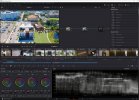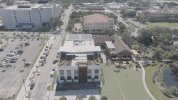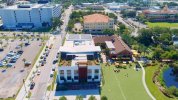I almost never shoot "Drone Videos" and instead shoot videos that happen to have some drone footage in them. But with the Autel EVO II 6K Pro I decided to really showcase what the camera and drone can do in a wide variety of situations including low light, night, and how the ALOG handles skin tones, sunset, and high dynamic range scenarios. So I came up with the "Explore Your World" concept and pushed the EVO II 6K's camera to its limits in a variety of challenging situations. The result is a camera campaign style video titled "Explore Your World".
You are using an out of date browser. It may not display this or other websites correctly.
You should upgrade or use an alternative browser.
You should upgrade or use an alternative browser.
EXPLORE YOUR WORLD: An Autel EVO II Pro 6K Cinematic Story
- Thread starter herein2021
- Start date
mdelrossi
Active Member
- Joined
- Feb 28, 2021
- Messages
- 27
- Reaction score
- 11
Nicely done.
One question, regarding the reds and oranges. I find that Autel seems to bump them up in saturation, and noticed that in your video as well. Were the sails on the boats around 1:58 that iridescent?
One question, regarding the reds and oranges. I find that Autel seems to bump them up in saturation, and noticed that in your video as well. Were the sails on the boats around 1:58 that iridescent?
Nicely done.
One question, regarding the reds and oranges. I find that Autel seems to bump them up in saturation, and noticed that in your video as well. Were the sails on the boats around 1:58 that iridescent?
Yes...they were pretty bright. Everything was shot in ALOG and I mostly conformed to Rec709 prior to a light creative grade. I always shoot ALOG, -2 sharpness -1 contrast. Pretty pleased with the skin tones, highlight rolloff, and low light performance. Shooting in ALOG and 10 bit the final color grade is pretty much whatever you make of it.
jcbff
New Member
Well done, a very enjoyable video.iI almost never shoot "Drone Videos" and instead shoot videos that happen to have some drone footage in them. But with the Autel EVO II 6K Pro I decided to really showcase what the camera and drone can do in a wide variety of situations including low light, night, and how the ALOG handles skin tones, sunset, and high dynamic range scenarios. So I came up with the "Explore Your World" concept and pushed the EVO II 6K's camera to its limits in a variety of challenging situations. The result is a camera campaign style video titled "Explore Your World".
Very nicely done indeed, Tampa?I almost never shoot "Drone Videos" and instead shoot videos that happen to have some drone footage in them. But with the Autel EVO II 6K Pro I decided to really showcase what the camera and drone can do in a wide variety of situations including low light, night, and how the ALOG handles skin tones, sunset, and high dynamic range scenarios. So I came up with the "Explore Your World" concept and pushed the EVO II 6K's camera to its limits in a variety of challenging situations. The result is a camera campaign style video titled "Explore Your World".
Well done, a very enjoyable video.i
Thank you
Very nicely done indeed, Tampa?
Parts were Tampa, I actually drove close to 1,000 miles all over FL to film the most interesting architecture, and events that I could find.
Eagle928
Well-Known Member
- Joined
- Feb 3, 2021
- Messages
- 703
- Reaction score
- 468
Very nice! You got skills!I almost never shoot "Drone Videos" and instead shoot videos that happen to have some drone footage in them. But with the Autel EVO II 6K Pro I decided to really showcase what the camera and drone can do in a wide variety of situations including low light, night, and how the ALOG handles skin tones, sunset, and high dynamic range scenarios. So I came up with the "Explore Your World" concept and pushed the EVO II 6K's camera to its limits in a variety of challenging situations. The result is a camera campaign style video titled "Explore Your World".
AirStreamPictures
Well-Known Member
Really nicely shot, Paul. And nicely graded.
are you shooting mostly in 4K for 10-bit or 6K?
Mostly 4K for 10bit. A few shots were 6K because I thought I would crop in later but when editing I didn't crop in on any of the shots.
D
Deleted member 6303
Guest
I never blow smoke and I have never ever learned as much as I have about Drone Video/Photo as I have with your articles, post and videos. Truly impressive. I hope you find time to do more.I almost never shoot "Drone Videos" and instead shoot videos that happen to have some drone footage in them. But with the Autel EVO II 6K Pro I decided to really showcase what the camera and drone can do in a wide variety of situations including low light, night, and how the ALOG handles skin tones, sunset, and high dynamic range scenarios. So I came up with the "Explore Your World" concept and pushed the EVO II 6K's camera to its limits in a variety of challenging situations. The result is a camera campaign style video titled "Explore Your World".
Enroute
Member
Great work. Thank you so much for sharing. I dread all the editing work required by shooting in log. For commercial work do you think I can shoot in NONE with proper exposure settings and get a quality product?
Great work. Thank you so much for sharing. I dread all the editing work required by shooting in log. For commercial work do you think I can shoot in NONE with proper exposure settings and get a quality product?
Actually LOG is very simple if you use the histogram for exposure while filming (treat it like a WFM) and Davinci Resolve to get a base Rec709 grade. From there add your creative adjustment clip...project color grade done. It literally takes me seconds to grade the LOG footage and I then copy the grade to subsequent clips from the same camera and make slight primaries adjustments to expand the clip's dynamic range based on the WF.
The Autel EVO II 6K's LOG profile is without a doubt the easiest drone LOG curve I've ever had to grade. By comparison, DJI was so bad that I shot in natural profile instead.
In my opinion, only the LOG profile will yield you maximum editing flexibility. Shooting in LOG vs a color profile is almost the same as shooting in RAW vs JPG for photography. The biggest thing LOG gets you is increased dynamic range and camera matching capabilities. Also, if you build up a large library of stock footage that you can use in different projects, source footage shot in LOG makes it easier to match different scenes and moods vs a baked in color profile.
My grading DR workflow for the LOG profile is very simple;
1 - Add the clip to the timeline
2 - Click the Color workspace
3 - Go to the Primaries section and ensure the Color Wheels are selected
4 - Color Boost +20, Saturation 100, Contrast 1.17
5 - Click the WB selector and if there is anything white in the scene that's properly exposed use that to set the WB.
6 - Select Scopes > Waveform and adjust the Lift until the bottom of the WF just touches off of 0 and adjust the gain until the WF just touches off of 1023.
7 - Color grade done. Keep in mind that it is critical that you properly exposed the scene while filming; if anything is clipped it is unrecoverable. Use the Histogram to ensure the elements in the scene that you care about are within the DR of the camera's sensor.
For years I was what we call LUT slappers in the video production world....you go find a LOG to Rec709 LUT and slap it on everything and then try to fix all of the damage it caused to your footage. No Rec709 conversion LUT can accommodate every possible lighting situation and so what they tend to do is destructively adjust your source footage in unrecoverable ways. Learning how to properly grade using a Rec709 WF Vector scope is the fastest way to getting the most out of your footage.
Below is a screen shot of my DR setup as well as the same image before and after the Rec709 grade. The only thing left is to place a creative grade over the project using an Adjustment clip to level the grade amongst all of the clips. I also do a few other things to the grade when needed; if you notice in the screen shot that I have 3 nodes in the graph, but those are only for specific scenarios which you won't run into very often.



Eagle928
Well-Known Member
- Joined
- Feb 3, 2021
- Messages
- 703
- Reaction score
- 468
With respect; if you are going to do commercial work your end product must be as good as you can make it. That means using LOG if needed and your ability to edit properly. Of course you can film and take pics in Auto mode if you like and still get a decent end product but the edited LOG will be better if done right.Great work. Thank you so much for sharing. I dread all the editing work required by shooting in log. For commercial work do you think I can shoot in NONE with proper exposure settings and get a quality product?
Just practice with a good editor until you feel like you're getting it right. No one learned how to do it overnight. It takes time and practice.
I cheat a little. I like to use a LUT to get me in the ballpark then edit it from there. I have photo settings I've saved to get a certain look. Again; this gets me close then I adjust from there. I'm just using free opensource software that works quite well IMHO. Shotcut for video and Rawtherapee for pics. Yes; RAW (CRZ) format produce better photos. It's all about dynamic range. I've seen some spectacular photos from JPEG's though so...
With respect; if you are going to do commercial work your end product must be as good as you can make it. That means using LOG if needed and your ability to edit properly. Of course you can film and take pics in Auto mode if you like and still get a decent end product but the edited LOG will be better if done right.
Just practice with a good editor until you feel like you're getting it right. No one learned how to do it overnight. It takes time and practice.
I cheat a little. I like to use a LUT to get me in the ballpark then edit it from there. I have photo settings I've saved to get a certain look. Again; this gets me close then I adjust from there. I'm just using free opensource software that works quite well IMHO. Shotcut for video and Rawtherapee for pics. Yes; RAW (CRZ) format produce better photos. It's all about dynamic range. I've seen some spectacular photos from JPEG's though so...
JPG's can definitely be perfectly acceptable, in fact the Olympics and most sporting events are shot 100% JPG because the photos are transmitted usually OTA straight to the editor's desks where they are uploaded to the public with commentary in near real time. In fact most sports shooters shoot in shutter priority mode, JPG, Auto ISO, synched WB, and let the camera do the rest.
RAW's real power comes into play when you need every single stop of DR, in mixed lighting scenarios, and for photos that will have extensive post processing performed. I shoot RAW 100% of the time and Manual Mode 95% of the time but it's probably overkill most of the time. However I'd rather have the RAW and not need it than need it and not have it.
Enroute
Member
I'm coming from the still photography world and I always shoot in Raw to maximize editing possibilities. Thank you so much for sharing the clarifications of editing in Log and how it is a comparison to RawvsJpeg in the still world. OK. You convinced me I need to do a deep dive in processing LOG. Having a LOG file for future possible use is a big plus as well. Thank you both herein and Eagle for sharing.
I'm coming from the still photography world and I always shoot in Raw to maximize editing possibilities. Thank you so much for sharing the clarifications of editing in Log and how it is a comparison to RawvsJpeg in the still world. OK. You convinced me I need to do a deep dive in processing LOG. Having a LOG file for future possible use is a big plus as well. Thank you both herein and Eagle for sharing.
Unfortunately LOG isn't quite as powerful as raw; you do not get as much latitude with the white balance; also, shadow recovery as well as highlight recovery is pretty much non existent since the source footage is still compressed in H.264 or H.265; but as long as you properly expose the scene it is the best way to take advantage of the full DR of the sensor. Highlight rolloff in particular is much more controlled when shooting LOG.
A really cool feature of the EVO II 6K is that the sensor is around 14 stops of DR and and so you get to take all of that DR and push and pull the footage in post to fit it into a 6 stop Rec709 color space so if you exposed properly you have far more source DR than you need to output the final project. This lets you really work with the mids without losing color accuracy which is always a challenge when trying to expose skin tones or wide DR scenes without fill lighting.
Color grading is a profession in and of itself and I am definitely not a colorist; I learned enough to get the best results out of my camera gear as quickly as possible, but I definitely do not know all of the tricks Hollywood colorists use nor do I want to. IMO there's a point of diminishing returns where you have to look at the client's budget and use that to determine how much time to allocate to the project or even to learning new techniques that will add substantial time to your workflow. For the main types of work that I do, I feel that I have a workflow that will get me commercially acceptable footage in the minimal amount of time for the cameras that I use.
Davinci Resolve has excellent training material for basic NLE navigation and their color grading training video is definitely one of the best out there. I did sit through their video titled "The Art of Color Grading" when transitioning from PP to Davinci Resolve and it will save you hours of frustration later. That video combined with a False color LUT is how I developed my 3 node process that lets me grade nearly anything out of nearly any camera within seconds to a Rec709 color space.
Last edited:
Similar threads
- Replies
- 1
- Views
- 685
- Replies
- 6
- Views
- 2K
- Replies
- 11
- Views
- 834
- Replies
- 0
- Views
- 1K



